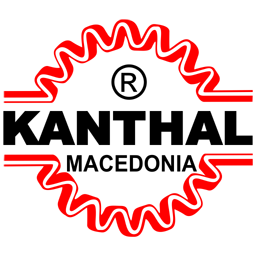KANTHAL MACEDONIA® D
High resistivity and low density, suitable for most applications
Other names: Alloy 815, AWS-825, Alchrome D
- Better protective alumina surface oxide layer for longer life
- Cost effective choice compared to A1
Kanthal D is a ferritic iron-chromium-aluminium alloy (FeCrAl alloy) for use at temperatures up to 1300°C (2370°F). The alloy is characterized by high resistivity and good oxidation resistance.
Kanthal D is used in home appliances and industrial furnaces. Typical applications in home appliances include metal sheathed tubular elements for dishwashers, elements embedded in ceramics for panel heaters, cartridge elements for plastic molding, heating cables and rope heaters in defrosting and deicing elements, mica elements used in irons, quartz tube heaters for space heating, industrial infrared dryers, in coils on molded ceramic fibre for boiling plates with ceramic hobs, in bead insulated coils for panel heaters,.
In industrial applications Kanthal D is used in, for example, terminals to furnace elements, porcupine elements for air heating, and in furnace heating elements.
Chemical compisition
| C % | Si % | Mn % | Cr % | Al % | Fe % | |
|---|---|---|---|---|---|---|
| Nominal composition | 4.8 | Bal. | ||||
| Min | - | - | - | 20.5 | - | |
| Max | 0.08 | 0.7 | 0.5 | 23.5 | - |
Mechanical properties
| Wire size | Yield strength | Tensile strength | Elongation | Hardness |
|---|---|---|---|---|
| Ø | Rp0.2 | Rm | A | |
| mm (in) | MPa (ksi) | MPa (ksi) | % | Hv |
| 1.0 (0.04) | 485 (70) | 670 (97) | 23 | 230 |
| 4.0 (0.16) | 450 (65) | 650 (94) | 18 | 230 |
MECHANICAL PROPERTIES AT ELEVATED TEMPERATURE
| Temperature °C (°F) | 900 (1652) |
| MPa (ksi) | 34 (4.9) |
Ultimate tensile strength - deformation rate 6.2 x 10-2/min
CREEP STRENGTH - 1% ELONGATION IN 1000 H
| Temperature °C (°F) | 800 (1472) | 900 (1652) |
| MPa (psi) | 1.2 (170) | 0.5 (73) |
Physical properties
| Density g/cm3 (lb/in3) | 7.25 (0.262) |
|---|---|
| Electrical resistivity at 20°C Ω mm2/m (Ω circ. mil/ft) | 1.35 (812) |
| Poisson's ratio | 0.30 |
YOUNG'S MODULUS
| Temperature °C | 20 | 100 | 200 | 400 | 600 | 800 | 1000 |
| Temperature °F | 68 | 212 | 392 | 752 | 1112 | 1472 | 1832 |
| GPa | 220 | 210 | 205 | 190 | 170 | 150 | 130 |
| Msi | 32 | 30 | 30 | 28 | 25 | 22 | 19 |
TEMPERATURE FACTOR OF RESISTIVITY
| Temperature °C | 100 | 200 | 300 | 400 | 500 | 600 | 700 | 800 | 900 | 1000 | 1100 | 1200 | 1300 |
| Temperature °F | 212 | 392 | 572 | 752 | 932 | 1112 | 1292 | 1472 | 1652 | 1832 | 2012 | 2192 | 2372 |
| Ct | 1 | 1.01 | 1.01 | 1.02 | 1.03 | 1.04 | 1.05 | 1.06 | 1.07 | 1.07 | 1.07 | 1.08 | 1.08 |
COEFFICIENT OF THERMAL EXPANSION
| Temperature °C (°F) | Thermal Expansion x 10-6/K (10-6 /°F) |
| 20 - 250 (68-482) | 11 (6.1) |
| 20 - 500 (68-932) | 12 (6.7) |
| 20 - 750 (68-1382) | 14 (7.8) |
| 20 - 1000 (68-1832) | 15 (8.3) |
Thermal conductivity
| Temperature °C | 50 | 600 | 800 | 1000 | 1200 |
| Temperature °F | 122 | 1112 | 1472 | 1832 | 2192 |
| W m-1 K-1 | 11 | 20 | 22 | 26 | 27 |
| Btu h-1ft-1°F-1 | 6.4 | 11.6 | 12.7 | 15 | 15.6 |
SPECIFIC HEAT CAPACITY
| Temperature °C | 20 | 200 | 400 | 600 | 800 | 1000 | 1200 |
| Temperature °F | 68 | 392 | 752 | 1112 | 1472 | 1832 | 2192 |
| kJ kg-1 K-1 | 0.46 | 0.56 | 0.63 | 0.75 | 0.71 | 0.72 | 0.74 |
| Btu lb-1 °F-1 | 0.11 | 0.13 | 0.15 | 0.18 | 0.17 | 0.17 | 0.18 |
| Melting point °C (°F) | 1500 (2732) |
|---|---|
| Max continuous operating temperature in air °C (°F) | 1300 (2372) |
| Magnetic properties | The material is magnetic up to approximately 600°C (1112°F)(Curie point). |
| Emissivity - fully oxidized material | 0.70 |
Resistivity vs. temperature chart for KANTHAL D and other KANTHAL alloys



